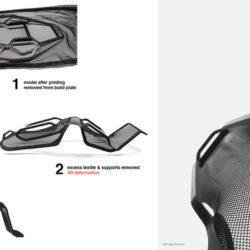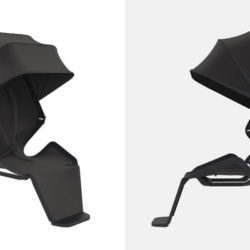2-3-4D
Description
In this master thesis a seat element for the transport of babies and toddlers was designed. The application is exemplary for the introduction phase of the new technology 3D printing on textiles and 4D textiles. The seating element was chosen because it is best suited to test the potential of the technology in an application-oriented manner.What is the Topic?
2-3-4D 2D designed, 3D printed, 4D formed. This work is about combining textiles with polymers using FDM printing processes, thereby giving them new forms and functions. By means of 3D and 4D printing, a hybrid material is created which only acquires its properties through the interaction of the materials. If a pre-tensioned textile is printed, it deforms the 3D-printed structure without external energy supply as soon as the tension is released. Since the change in shape only occurs after the manufacturing process, these new materials are called 4D textiles, derived from the term 4D printing. This technology allows an initially planar geometry to be transformed into a complex three-dimensional structure. The geometry of the printed material thus plays a central role in this work. At the core of the work is the question of how concepts can be developed from observed material properties and how a free, experimental design process can reveal potentials that might have remained unrecognised if the focus had been on a previous objective. Such processes play a special role in the introduction phase of a technology, as is currently the case with 3D printing on textiles.
Why does it look like this?
The shape of the seat element results from the targeted material design, the interaction of the materials and the geometry of the printed material. Based on a series of free experiments that served as inspiration for the seat, the parameters for seat angle, 4D deformation and stability were formulated. The seat element was then developed in an iterative design process. Based on the material behaviour, geometry and pressure parameters were adjusted again and again until the functionality of the seating element was given (based on the findings of previous user research).
What is special?
What is special about this work is the approach of material-based design. In contrast to the traditional design process, where materials are often not selected until the development phase, here the material was placed at the beginning of the design process. By recognising special properties, changing (print) parameters and experimenting with opposing material properties and combinations, unexpected functional solutions were created. In this approach, the shape of the final product is directly influenced by the material behaviour. Material and technologies thus become the main source of inspiration for the design process, which in turn makes the possibilities of the material visible in the first place. Another special feature: in 4D printing, the object is not yet finished when the manufacturing process is complete: only after it has been removed from the printing plate does the deformation begin; the time dimension becomes visible. Currently there is no software available that can realistically simulate this change in shape, as the material combinations in particular are too complex for corresponding calculations. In order to be able to control the change of shape by adjusting material and geometry, an iterative approach and a lot of trial and error is necessary. Predicting how a minimal change in the code would affect the material behaviour was definitely a special feature of this work.
What is new?
The technology allows us to completely rethink the design of a seat, as it can be manufactured in a simple and cost-effective 2D manufacturing process. This is one of the greatest potentials of 4D printing: it simplifies the production of complex objects and significantly reduces the use of materials. In the case of buggies in particular, it is easy to see that functionality and quality are often achieved through complex designs and the extensive use of materials. The example of the child seat shows that this can also be achieved in other ways. The combination of textiles with 3D-printed material also enables a completely new design language. The shape of the seat is achieved by the interaction of the materials, only the upper connection to the frame is necessary to hold the backrest in the desired position. Instead of using a textile to cover uncomfortable materials and elaborate mechanics, the high-tech capabilities of the textile are used here to ensure maximum comfort (support and simultaneous adaptation to the body) and optimum climate control, as well as saving weight and space. These are particularly important criteria in the field of mobility. The seat is flexible in the middle. This means that the seat can be adjusted to the sleeping position and folded for transport and no additional construction on the seat is necessary.




